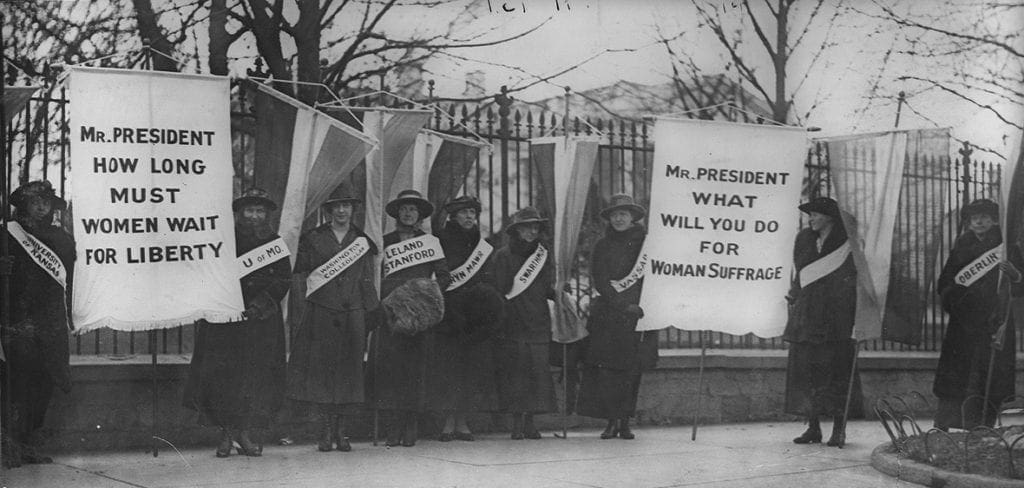We are going to start the #19SuffrageStories with a well-known figure in the Suffrage Movement, Lucy Burns!
Lucy was born in 1879 to an Irish Catholic family in Brooklyn, New York. A well-educated student of language and linguistics, Lucy graduated from Vassar College before studying abroad. It was at Oxford College in England where she first encountered the militant British Suffrage Movement. Inspired by these women, Lucy left Oxford to join British Women’s Social and Political Union, led at the time by Emmeline Pankhurst. While in Europe, Lucy participated in protests and demonstrations, frequently being arrested. It was here that she first met fellow suffragist Alice Paul. The two would go on to become good friends and fighters for the suffrage movement back in the United States.
In 1912, the pair moved to Washington to lead the Congressional Committee of the National American Woman Suffrage Association (NAWSA) whose goal was to work towards an amendment to the US Constitution granting women the right to vote. Burns and Paul organized the well-known 1913 march down Pennsylvania Avenue the day before President Wilson’s inauguration before the two had a falling out with NAWSA leaders. The two women disagreed with NAWSA goals and tactics that focused more on advocating for the right to vote at the state level instead of nationally. NAWSA leaders, like Carrie Chapman Catt, felt Paul and Burns were too aggressive, fearing they would turn many away from the movement. Paul and Burns left the organization and formed the Congressional Union for Woman Suffrage (CU) in 1914 which would later become the National Woman’s Party (NWP) in 1916. The relentless and militant demonstrations from the National Woman’s Party kept the movement in the news.

Though keeping a lower profile than the outspoken Paul, Burns is often described as having a firecracker personality to match her distinct fire red-hair. She spent time as the editor of the NWP’s publication The Suffragist, spoke to crowds on street corners to increase support and passion for the movement, and even led the prominent picketing campaign outside the White House. The women stood outside of the White House day after day for months, drawing increased attention towards their cause. Public opinion became increasingly negative, however, as America became involved in the First World War and the women refused to pause their protests. After carrying a sign accusing President Wilson of deceit and hypocrisy when discussing democracy, Burns and the other women were faced with violent counter protesters and repeated arrest. Lucy herself was arrested six times during this campaign, and was a victim of the Occoquan Workhouse “Night of Terror” where guards beat and tortured the women throughout the night. Burns had her arms handcuffed above her head all night and was brutally force-fed after leading a hunger strike against the women’s treatment by the guards. Lucy Burns, and suffragists across the country, continued to fight for women’s suffrage until the 19th amendment was passed on August 26th, 1920. The fight for women’s rights, and suffrage for many women, would be far from over. Despite this, Burns made the decision to retire from activism, stating “I don’t want to do anything more. I think we have done all this for women, and we have sacrificed everything we possessed for them, and now let them fight for it now. I am not going to fight anymore.”

To learn more about Lucy Burns, check out..
The Lucy Burns Museum https://www.workhousearts.org/lucyburnsmuseum/
The National Park Service https://www.nps.gov/people/lucy-burns.htm
The Library of Congress https://www.loc.gov/collections/women-of-protest/articles-and-essays/selected-leaders-of-the-national-womans-party/visionaries/
Citations:
Lucy Burns (U.S. National Park Service). (n.d.). Retrieved August 05, 2020, from https://www.nps.gov/people/lucy-burns.htm
Lucy Burns Museum. (n.d.). Retrieved August 05, 2020, from https://www.workhousearts.org/lucyburnsmuseum/
Visionaries : Selected Leaders of the National Woman’s Party : Articles and Essays : Women of Protest: Photographs from the Records of the National Woman’s Party : Digital Collections : Library of Congress. (n.d.). Retrieved August 05, 2020, from https://www.loc.gov/collections/women-of-protest/articles-and-essays/selected-leaders-of-the-national-womans-party/visionaries/
Historical Overview of the National Womans Party : Articles and Essays : Women of Protest: Photographs from the Records of the National Woman’s Party : Digital Collections : Library of Congress. (n.d.). Retrieved August 05, 2020, from https://www.loc.gov/collections/women-of-protest/articles-and-essays/historical-overview-of-the-national-womans-party/